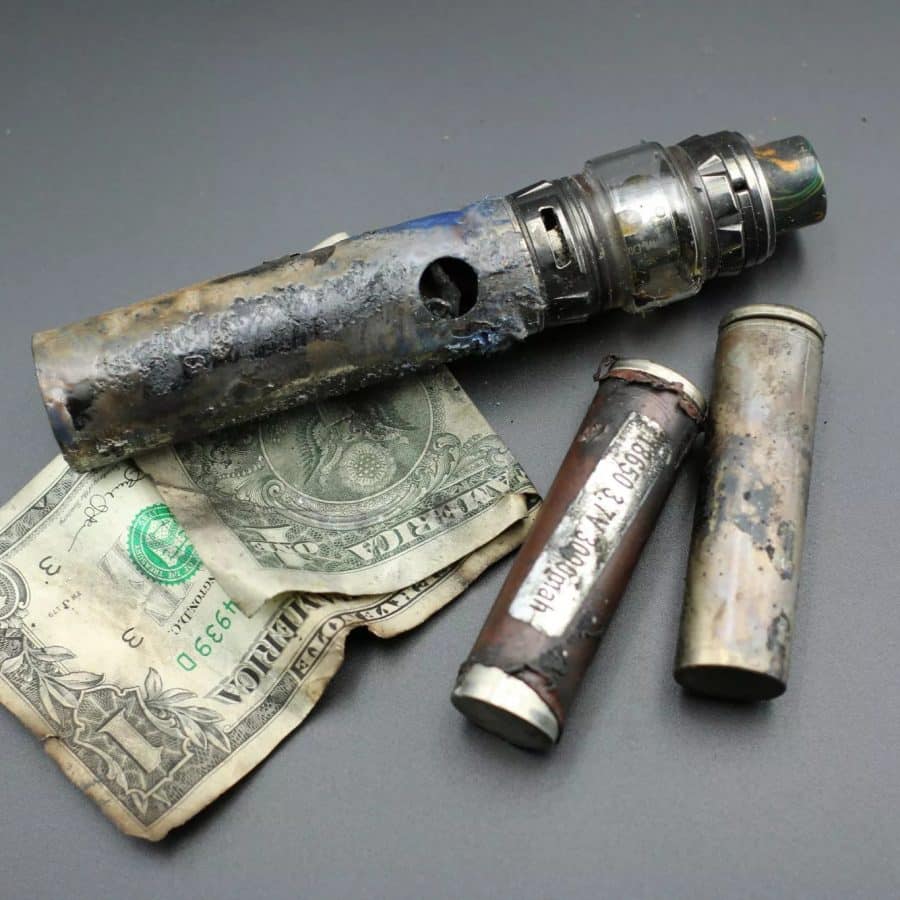E-cigarettes continue to pose a severe hazard to consumers, with more than 2,000 burn and explosion injuries occurring between 2015-2017 alone. And those numbers are definitely lower than the actual occurrences: there is no centralized database for reporting e-cigarette explosions, so academics had to cobble these figures together from various sources. We’ve seen the rise of this problem firsthand, with more and more clients being severely injured after their vape pens suddenly exploded. Our experience and knowledge gained through litigating these cases leads to one conclusion—e-cigarettes will continue to explode and burn, injure, and kill consumers.
This article will provide a brief overview of the explosion risk posed by e-cigarettes, the process of investigating an e-cigarette case, and the unique set of pitfalls and obstacles in this litigation.
Why do e-cigarettes explode?
E-cigarettes mimic the sensation of smoking tobacco by releasing a vapor resembling traditional cigarette smoke. To do so, the devices contain a heating element which vaporizes a liquid solution (often a combination of nicotine, flavoring, and various chemicals). The heating device, in turn, is powered by a lithium ion battery. And that’s where the danger lies: lithium ion batteries are able to hold large amounts of energy, but also contain flammable electrolytes and other volatile components that will catch on fire if exposed to oxygen. The batteries have internal safeguards, but these safeguards can degrade due to internal heat and pressure generated by the batteries (a process called “thermal runaway”). And that’s when fires and explosions can and do happen.
The explosions can be incredibly dangerous. Examples of media reports about injuries attributed to e-cigarette explosions from the past few years include:
- A semi-truck driver who suffered facial injuries and crashed his truck after his e-cigarette allegedly exploded while he was driving;
- A woman who suffered severe burns and lost two teeth after her e-cigarette allegedly “exploded and caused her car to go up in flames;”
- A former professional soccer player who is now “unrecognizable” after an e-cigarette allegedly “exploded in his mouth” and “the product’s battery blew through his cheek;”
- A woman who suffered third-degree burns to her legs when an e-cigarette allegedly exploded in her pocket—she further claims that “the battery exploded with such force that it became lodged in her car’s dashboard;”
- A teenager who has been left completely blind in his left eye; and
- A teenager whose vape exploded in his mouth, putting a hole in his jaw and breaking several teeth.
Pre-suit investigation: identifying defendants and gathering evidence.
E-cigarette cases revolve around traditional products liability theories, including strict liability, negligence, and failure to warn. This means that the defendants in an e-cigarette case are those entities and individuals in the “chain of distribution,” including:
- The manufacturers of the battery and other component parts comprising the e-cigarettes (often multiple companies are involved in creating the various parts);
- The importer—most e-cigarettes are manufactured overseas, and then brought into the U.S. by companies located here;
- The distributor of the e-cigarette, batteries, and other components; and
- The retailer which sold the e-cigarette and its various components parts to the client.
Identifying the defendants in a given case is more difficult than one might think at first blush. The client will often only know the name or location of the store where the e-cigarette was purchased. This is often enough to identify the retailer, but not the other potential defendants. The manufacturers and, less often the importer and distributor, can sometimes be identified from the e-cigarette labelling, or from the product packaging. But sometimes the labelling is not legible or does not adequately identify the responsible parties. In those instances, identifying the other defendants might require independent investigation, discovery from the retailer concerning its purchasing practices, and coordination with other plaintiff attorneys who have handled similar claims.
The other critical step in pre-suit investigation is gathering and preserving all of the required evidence. This will vary from case to case, so it’s important to sit down with your team early on, figure out what evidence is important based on the unique facts at hand, and make sure everyone is on the same page. Of course, the product itself (assuming any of it remains) and the packaging it came in typically constitute important evidence in pursuing the case, so they should be preserved if possible. Likewise, receipts and other documentation the client obtained at the point of sale should be preserved. It may also be necessary to visit the websites of the entities in the chain of distribution and preserve the pages (sometimes they contain incriminating admissions), both by downloading them and by using online archiving tools. In some cases, as with those where an e-cigarette caught fire in a pants pocket, the clothing the injured client was wearing at the time of the incident should also be preserved for litigation purposes.
Pitfalls and obstacles in the litigation.
E-cigarette cases present several unique challenges. Jurisdictional disputes are probably the most common and most difficult obstacles. Most e-cigarettes are manufactured overseas—often in China—with multiple companies standing between the companies which produced the product and the end consumer. At the same time, the U.S. Supreme Court has recently issued a rash of personal jurisdiction cases which have gone against consumers. While those cases involve attenuated circumstances dissimilar to most e-cigarette cases, overseas defendants frequently bend those opinions in the hopes of getting trial courts to bite. Results are mixed. Overworked trial court judges sometimes get lost in the details and agree with the defendants’ distorted readings of the case law. And even if the plaintiff is victorious, the jurisdictional fights can drag on for months or years, depending on the amount of discovery needed and the availability of hearing time—constituting a partial temporal “win” in the form of delay for the defense.
Another common challenge in e-cigarette cases is the multitude of “blame the victim” defenses which are frequently presented. One common refrain from the e-cigarette lobby has been that the products explode because of “user error.” The common theme of the “user error” defense is that the consumer has “overcharged” or improperly inserted the battery into the device. Similarly, the defendants also like to point to modifications of the devices as the reason for explosions. It is no secret that the practice of “vape modding,” which involves adding new hardware, batteries, or other components to an e-cigarette, has become incredibly popular within the e-cigarette industry over the past several years. In the legal setting, well-paid defense lawyers will try to use this wrinkle to bar the courthouse doors, arguing that any such modification constitutes a “substantial alteration” of the product. If the facts of a case implicate a potential misuse or modification defense, it is important to anticipate such an argument and be prepared to rebut it, including by the development of expert proof that any alleged misuse or modification did not cause or contribute to the incident. It may also be possible to turn these defenses into good offensive claims by properly posturing a failure to warn or instructional defect theory.
Finally, e-cigarette retailers are often fly-by-night operations which have minimal assets. This unfortunate reality, combined with possible jurisdictional defenses, means that finding insurance coverage is more important in e-cigarette cases than most other products liability disputes. And while the insurers are happy to collect premiums from companies which specialize in selling vapes, they are less happy to pay on claims and sometimes look for (and even manufacture) arguments to avoid coverage. As a result, it is often necessary to concurrently litigate insurance coverage disputes along with the products liability claims. We’ve already had to do this exact thing and expect similar challenges in the future.
Conclusion.
E-cigarettes will continue to injure, disfigure, and kill Americans into the foreseeable future. Sadly, the unique barriers to recovery (foreign defendants, “blame the victim” defenses, and insurance coverage disputes) make these claims difficult and expensive to pursue. But with the right combination of determination, resources, and legal expertise, these cases can provide significant recoveries for the victims. Feel free to give us a call if you have any questions. We’re happy to share our knowledge and help out in any way you would like.


